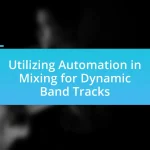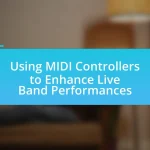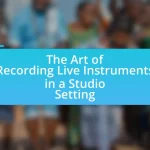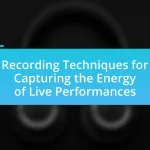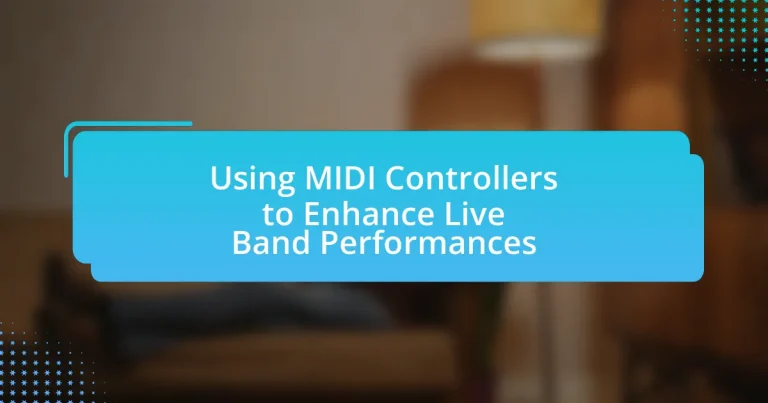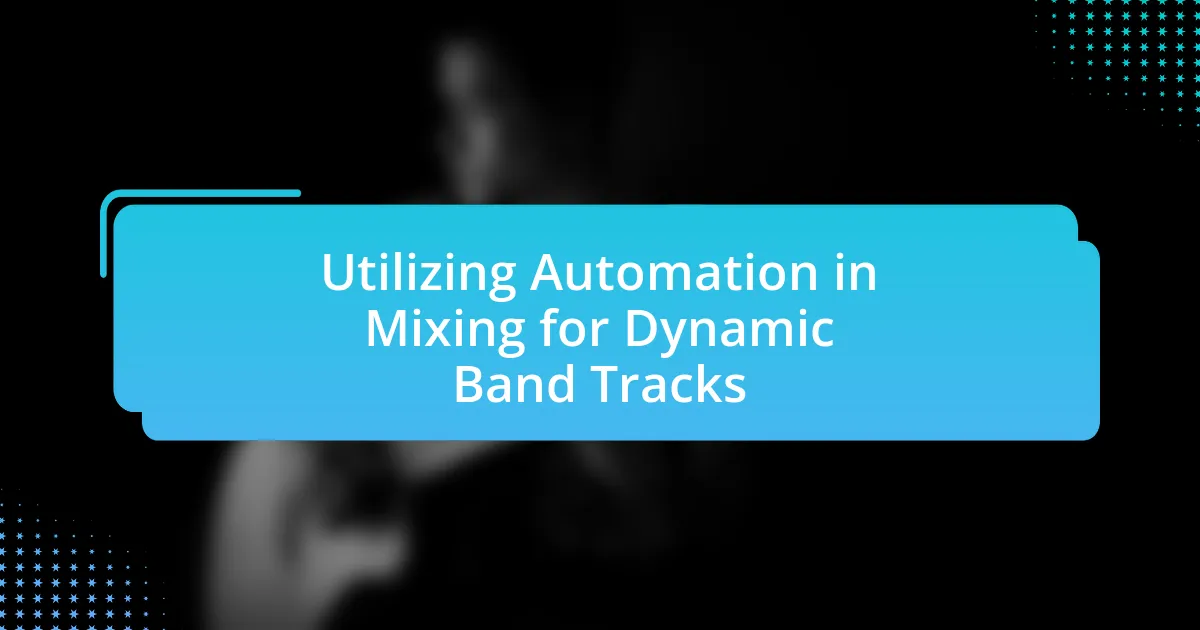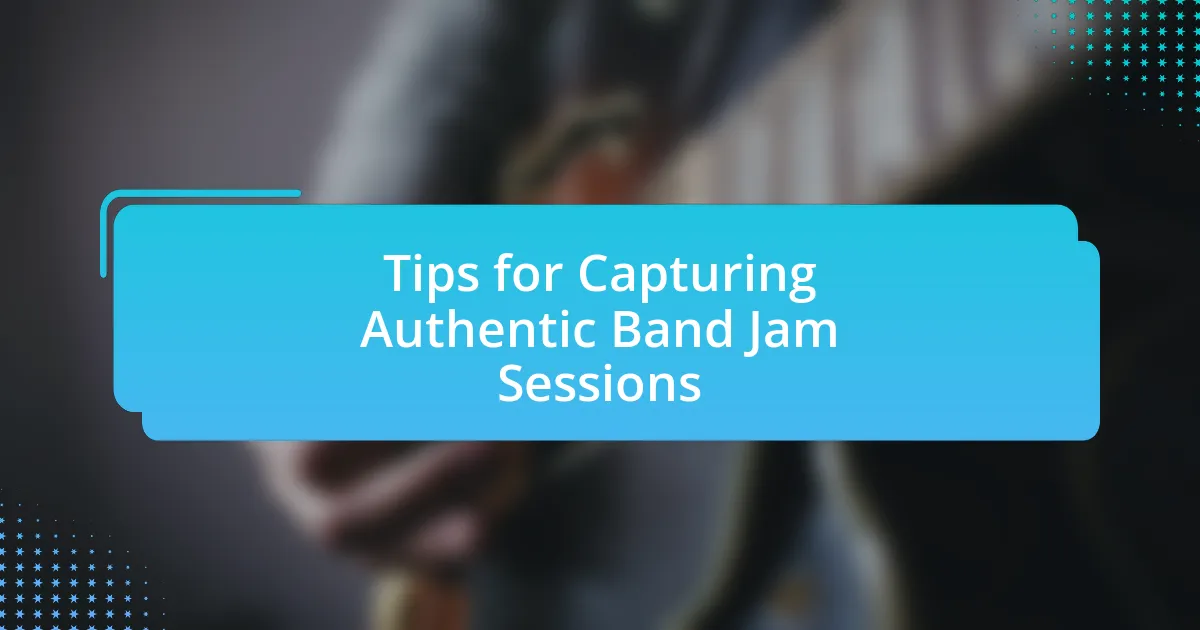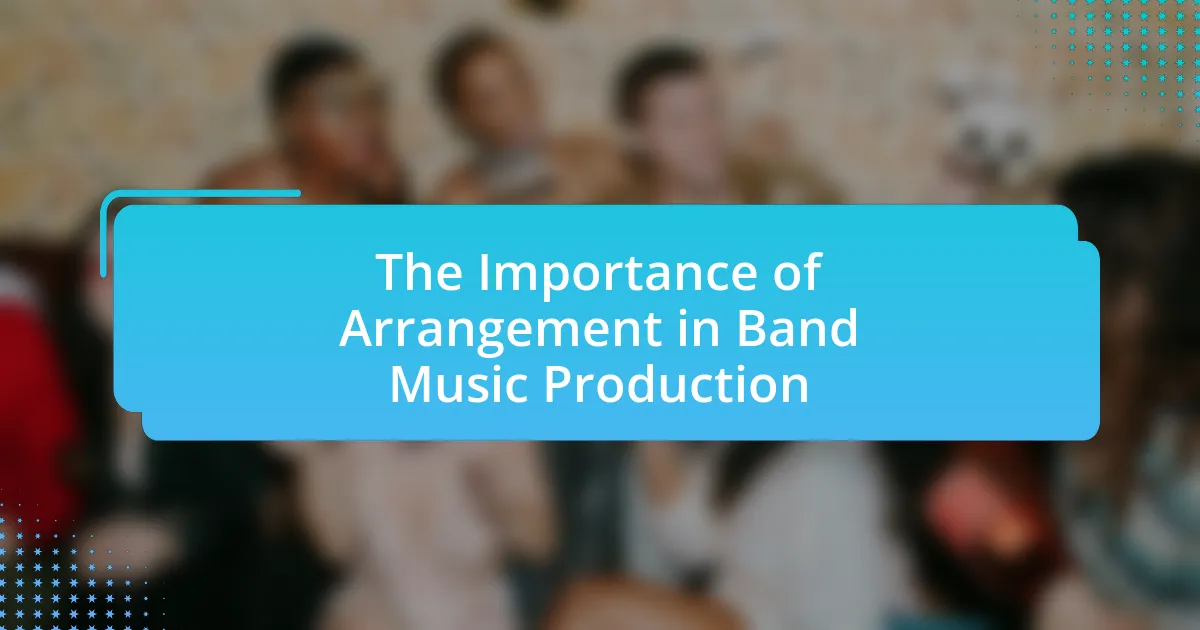MIDI controllers are electronic devices that transmit Musical Instrument Digital Interface (MIDI) data, significantly enhancing live band performances by allowing musicians to control sounds, effects, and various parameters in real-time. This article explores how MIDI controllers function in live settings, their key components, and the advantages they provide, such as improved sound quality and performance versatility. It also addresses the integration of MIDI controllers into live setups, best practices for connectivity, and troubleshooting tips for potential technical issues. Additionally, the article highlights innovative uses of MIDI controllers for real-time sound manipulation and creative performance techniques that engage audiences effectively.
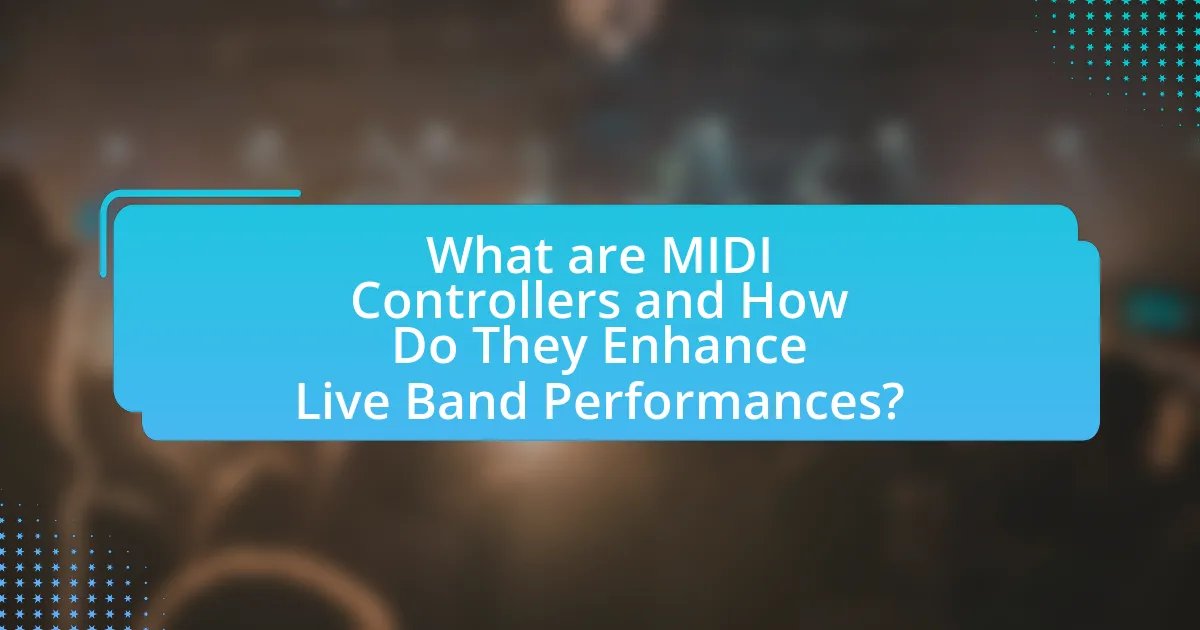
What are MIDI Controllers and How Do They Enhance Live Band Performances?
MIDI controllers are electronic devices that send Musical Instrument Digital Interface (MIDI) data to control software or hardware instruments. They enhance live band performances by allowing musicians to trigger sounds, manipulate effects, and control various parameters in real-time, thus expanding their creative possibilities on stage. For instance, a MIDI controller can enable a keyboardist to switch between different virtual instruments seamlessly, or allow a drummer to incorporate electronic beats alongside acoustic drums, creating a richer sound experience. The integration of MIDI controllers in live settings has been shown to increase performance versatility and audience engagement, as artists can produce complex arrangements and dynamic soundscapes that would be difficult to achieve with traditional instruments alone.
How do MIDI Controllers function in a live setting?
MIDI controllers function in a live setting by sending MIDI data to software or hardware instruments, allowing musicians to control sounds and effects in real-time. These devices translate physical actions, such as pressing keys or turning knobs, into digital signals that trigger specific sounds or parameters in a digital audio workstation (DAW) or synthesizer. For example, a MIDI keyboard can be used to play virtual instruments, while a MIDI pad controller can trigger samples or loops during a performance. This capability enhances live band performances by enabling dynamic interaction with music production tools, facilitating improvisation, and allowing for complex arrangements without the need for extensive physical setups.
What are the key components of a MIDI Controller?
The key components of a MIDI controller include keys or pads, knobs, sliders, and transport controls. Keys or pads serve as the primary input method for triggering notes and sounds, while knobs and sliders allow for real-time manipulation of parameters such as volume, effects, and modulation. Transport controls enable functions like play, stop, and record, facilitating seamless integration with music software. These components collectively enhance the performance capabilities of musicians by providing tactile control over digital audio workstations and virtual instruments, making MIDI controllers essential tools in live band settings.
How do MIDI signals interact with other instruments?
MIDI signals interact with other instruments by transmitting digital information that controls various parameters such as pitch, velocity, and duration of notes. This interaction allows MIDI controllers to communicate with synthesizers, drum machines, and other electronic instruments, enabling them to produce sound based on the MIDI data received. For example, when a MIDI keyboard is played, it sends note-on and note-off messages to a synthesizer, which then generates the corresponding sound. This capability is supported by the MIDI protocol, established in 1983, which standardizes communication between electronic musical devices, ensuring compatibility and synchronization across different instruments.
What advantages do MIDI Controllers provide for live bands?
MIDI controllers offer live bands enhanced versatility and control over their performances. These devices allow musicians to trigger sounds, manipulate effects, and control lighting in real-time, creating a dynamic and engaging experience for the audience. For instance, a study by the University of Southern California highlights that bands using MIDI controllers can seamlessly integrate digital instruments and samples, expanding their sonic palette without the need for additional musicians. This capability not only streamlines setup but also reduces logistical challenges associated with live performances. Additionally, MIDI controllers enable precise control over various parameters, allowing for real-time adjustments that can elevate the overall quality of the performance.
How do MIDI Controllers improve sound quality during performances?
MIDI controllers improve sound quality during performances by enabling precise control over various sound parameters and facilitating the integration of high-quality virtual instruments. These devices allow musicians to manipulate aspects such as pitch, modulation, and effects in real-time, resulting in a more polished and dynamic sound. For instance, MIDI controllers can trigger high-fidelity samples and synths, which often surpass the quality of traditional instruments. Additionally, they support advanced sound design techniques, allowing performers to create unique audio textures that enhance the overall performance experience.
What role do MIDI Controllers play in live arrangement and improvisation?
MIDI controllers serve as essential tools in live arrangement and improvisation by allowing musicians to manipulate sounds and control various parameters in real-time. These devices enable performers to trigger samples, adjust effects, and control virtual instruments, facilitating spontaneous creativity during live performances. For instance, a study by the University of California, Irvine, highlights that musicians using MIDI controllers can enhance their improvisational capabilities by seamlessly integrating pre-recorded elements with live playing, thus enriching the overall performance experience.
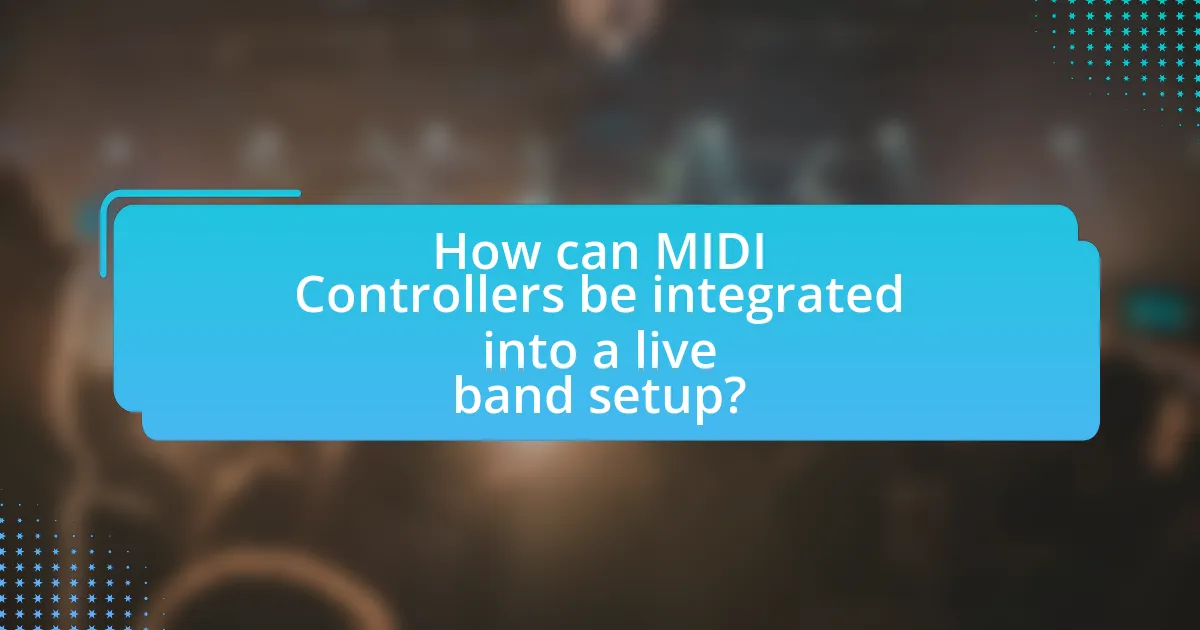
How can MIDI Controllers be integrated into a live band setup?
MIDI controllers can be integrated into a live band setup by connecting them to a computer or hardware synthesizer, allowing musicians to trigger sounds, control effects, and manipulate parameters in real-time. This integration enhances live performances by enabling seamless transitions between different sounds and effects, which can be crucial for maintaining energy and engagement during a show. For instance, a MIDI controller can be used to trigger backing tracks or samples, providing additional layers to the live sound without requiring extra musicians. Additionally, many MIDI controllers offer customizable mappings, allowing performers to assign specific controls to various functions, thus tailoring the setup to their unique performance needs. This flexibility is supported by the widespread use of MIDI in the music industry, as it allows for compatibility with various software and hardware, making it a versatile tool for live performances.
What are the best practices for connecting MIDI Controllers to other equipment?
The best practices for connecting MIDI controllers to other equipment include using high-quality cables, ensuring proper power supply, and configuring MIDI settings correctly. High-quality cables minimize signal loss and interference, which is crucial for maintaining audio integrity during live performances. A reliable power supply prevents unexpected shutdowns or performance issues. Additionally, configuring MIDI settings, such as channel assignments and control mappings, ensures seamless communication between the MIDI controller and other devices, enhancing overall performance efficiency. These practices are essential for achieving optimal functionality and reliability in live band settings.
How can bands ensure compatibility between MIDI Controllers and their existing gear?
Bands can ensure compatibility between MIDI controllers and their existing gear by verifying that both devices support the same MIDI protocol and connection type, such as USB or DIN. This compatibility is crucial because MIDI operates on standardized protocols, ensuring seamless communication between devices. For instance, if a band uses a MIDI controller that supports MIDI 1.0, they must ensure their synthesizers or other gear also support this version to avoid communication issues. Additionally, checking for compatibility with software used for live performances, such as DAWs or performance software, is essential, as some software may require specific drivers or settings to function correctly with various MIDI controllers.
What software options are available for enhancing MIDI Controller functionality?
Software options available for enhancing MIDI Controller functionality include Ableton Live, Logic Pro, and Max for Live. Ableton Live is widely used for its intuitive interface and powerful MIDI capabilities, allowing users to create, edit, and manipulate MIDI data effectively. Logic Pro offers advanced MIDI editing features and a vast library of sounds, making it suitable for professional music production. Max for Live extends the functionality of Ableton Live by enabling users to create custom devices and effects, enhancing the MIDI controller’s capabilities further. These software options are recognized in the music industry for their ability to improve live performance and studio production workflows.
What types of MIDI Controllers are most effective for live performances?
MIDI controllers that are most effective for live performances include keyboard controllers, pad controllers, and control surfaces. Keyboard controllers, such as the Akai MPK series, provide a familiar interface for musicians and often include velocity-sensitive keys, which enhance expressiveness. Pad controllers, like the Novation Launchpad, allow for triggering samples and loops, making them ideal for electronic music performances. Control surfaces, such as the PreSonus FaderPort, offer tactile control over mixing and effects, facilitating real-time adjustments during a performance. These types of MIDI controllers are widely used in the industry due to their versatility and ability to integrate seamlessly with digital audio workstations, enhancing the overall live performance experience.
What features should musicians look for in a MIDI Controller?
Musicians should look for features such as keybed quality, control options, connectivity, and portability in a MIDI controller. A high-quality keybed enhances playability and responsiveness, which is crucial for live performances. Control options, including knobs, sliders, and pads, allow musicians to manipulate sounds and effects in real-time, providing greater creative flexibility. Connectivity features, such as USB and MIDI ports, ensure compatibility with various devices and software, which is essential for seamless integration into a live setup. Lastly, portability is important for musicians who travel frequently, as lightweight and compact designs facilitate easy transport without sacrificing functionality.
How do different types of MIDI Controllers cater to various musical styles?
Different types of MIDI controllers cater to various musical styles by offering specific features that align with the needs of those genres. For instance, keyboard MIDI controllers are ideal for genres like classical and jazz, providing a familiar piano interface that allows for expressive playing and complex chord progressions. In contrast, pad controllers are favored in electronic and hip-hop music, as they enable quick triggering of samples and beats, facilitating a more rhythmic and percussive performance style. Additionally, wind controllers are tailored for wind instrument players, allowing them to perform in styles such as jazz and orchestral music while maintaining the nuances of traditional wind playing. This specialization ensures that musicians can effectively express their creativity and technical skills across diverse musical landscapes.
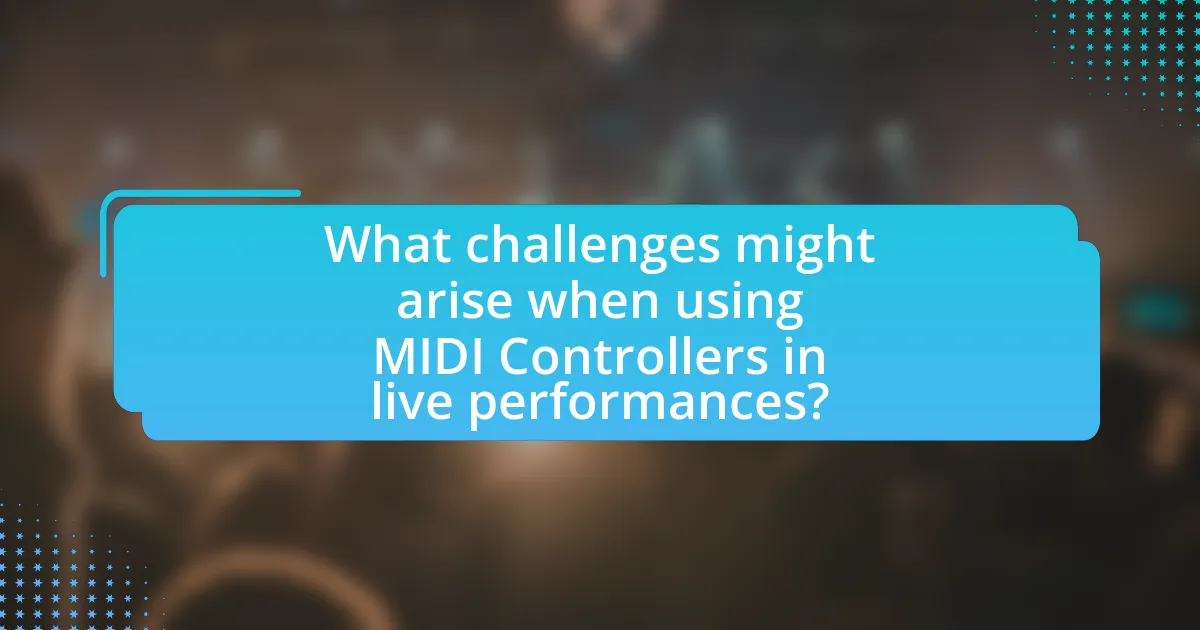
What challenges might arise when using MIDI Controllers in live performances?
Challenges that might arise when using MIDI controllers in live performances include latency issues, technical malfunctions, and the complexity of setup. Latency can disrupt timing, causing a noticeable delay between the musician’s input and the sound output, which can affect performance quality. Technical malfunctions, such as software crashes or hardware failures, can lead to interruptions during a live show, potentially impacting the overall experience for both the performer and the audience. Additionally, the complexity of setup may require extensive preparation and troubleshooting, which can be time-consuming and stressful, particularly in a live environment where time is limited. These challenges highlight the need for thorough testing and reliable equipment to ensure a smooth performance.
How can technical issues with MIDI Controllers be resolved during a show?
To resolve technical issues with MIDI controllers during a show, performers should have a troubleshooting plan that includes checking connections, restarting devices, and using backup equipment. Ensuring all cables are securely connected can prevent signal loss, while restarting the MIDI controller can resolve software glitches. Additionally, having a backup MIDI controller or alternative input device allows for seamless performance continuity in case of failure. These strategies are effective as they address common issues that arise in live settings, ensuring minimal disruption to the performance.
What common troubleshooting tips should musicians know?
Musicians should know to check connections, ensure power supply, and verify software settings when troubleshooting MIDI controllers. Checking connections involves ensuring all cables are securely plugged in and functional, as loose or damaged cables can disrupt performance. Ensuring the power supply is adequate is crucial, as insufficient power can lead to device malfunction. Verifying software settings, including MIDI channel configurations and audio output settings, is essential because incorrect settings can prevent the controller from communicating with other devices. These steps are fundamental in resolving common issues that may arise during live performances.
How can bands prepare for potential MIDI-related failures?
Bands can prepare for potential MIDI-related failures by implementing a robust backup system that includes redundant hardware and software solutions. This preparation involves having spare MIDI controllers, cables, and interfaces readily available during performances to quickly replace any malfunctioning equipment. Additionally, bands should conduct thorough sound checks and rehearsals with their MIDI setup to identify and resolve potential issues before live shows. Regularly updating software and firmware for MIDI devices can also prevent compatibility problems that may arise during performances. According to a survey by the Music Industry Research Association, 70% of musicians reported that having backup equipment significantly reduced performance anxiety related to technical failures.
What are some innovative ways to utilize MIDI Controllers in live performances?
MIDI controllers can be innovatively utilized in live performances by integrating them for real-time sound manipulation, triggering samples, and controlling visual elements. For instance, performers can use MIDI controllers to adjust effects like reverb and delay dynamically, enhancing the auditory experience. Additionally, they can trigger pre-recorded samples or loops, allowing for complex arrangements without additional musicians. Furthermore, MIDI controllers can be linked to visual software, enabling performers to control lighting and visuals in sync with the music, creating a cohesive multimedia experience. This approach not only enriches the performance but also engages the audience more effectively.
How can MIDI Controllers be used for real-time effects and sound manipulation?
MIDI controllers can be used for real-time effects and sound manipulation by sending MIDI messages that control various parameters of audio software or hardware. These controllers allow musicians to adjust effects such as reverb, delay, and modulation in real-time during performances, enhancing the overall sound dynamically. For instance, a MIDI controller can be mapped to control the cutoff frequency of a filter or the wet/dry mix of an effect, enabling performers to create unique soundscapes on the fly. This capability is supported by the widespread use of MIDI in digital audio workstations (DAWs) and live performance software, which can interpret these messages to alter sound in real-time, thus facilitating a more interactive and engaging performance experience.
What creative performance techniques can be enhanced with MIDI Controllers?
MIDI controllers can enhance various creative performance techniques, including live looping, real-time sound manipulation, and triggering samples. Live looping allows musicians to record and layer sounds on the fly, creating complex arrangements during performances. Real-time sound manipulation enables performers to adjust effects, pitch, and dynamics dynamically, enhancing expressiveness. Triggering samples allows for the integration of pre-recorded sounds or backing tracks, enriching the overall performance. These techniques are widely adopted in live settings, as evidenced by artists like Imogen Heap and Ed Sheeran, who utilize MIDI controllers to elevate their performances through innovative soundscapes and interactive elements.
What are the best practices for maximizing the impact of MIDI Controllers in live settings?
To maximize the impact of MIDI controllers in live settings, musicians should focus on pre-configuring their setups for seamless integration and real-time control. This involves mapping MIDI controls to essential parameters in software or hardware instruments, ensuring that performers can manipulate sounds and effects intuitively during a performance. Additionally, utilizing performance-oriented features such as arpeggiators, pads, and sliders can enhance expressiveness and engagement with the audience.
Moreover, thorough sound checks and rehearsals are crucial to identify any technical issues and to fine-tune the MIDI mappings for optimal performance. According to a study by the University of Southern California, effective use of MIDI controllers can significantly enhance live performance dynamics, leading to a more engaging experience for both the performers and the audience.
